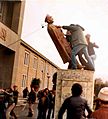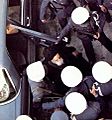Islamic Revolution facts for kids
The Islamic Revolution was a big change that happened in Iran in 1979. Iran is a country where most people are Muslim. Before the revolution, Iran was led by a powerful ruler called the Shah, Mohammed Reza Pahlavi. He wanted Iran to be more like Western countries, with less focus on religious laws in government.
However, many people, especially those who followed Islamist ideas, did not agree with the Shah's policies. They wanted a government that followed Islamic principles more closely. Supporters of Ayatollah Khomeini started to protest against the Shah's rule.
Ayatollah Khomeini became the new leader of Iran after the revolution. In a public vote, 98.2% of Iranians voted to create the Islamic Republic of Iran. This meant changing from a monarchy (where a king or queen rules) to a republic based on religious laws. Some countries in the West still say this new republic is authoritarian.
Soon after the revolution, Iraq, led by Saddam Hussein, started a war with Iran. This war, known as the Iran-Iraq War, lasted until 1988. Neither side truly won, and it caused a lot of damage.
Contents
What Happened After the Revolution?
The Islamic Revolution had a huge impact on Iran and its people. Many Iranians had to leave their homes and move to other countries during this time.
Human Cost of the Revolution
The revolution and the war that followed led to many deaths. It is thought that between 3,000 and 60,000 Iranians died during the protests against the Shah and the war with Iraq. Also, around 8,000 people were executed by the new government's courts.
The Hostage Crisis
During the revolution, 52 Americans were taken hostage. They were seized from the U.S. Embassy in Iran. This event caused a lot of tension between Iran and the United States.
Related pages
Images for kids
-
The Shah of Iran (left) meeting with members of the U.S. government: Alfred Atherton, William Sullivan, Cyrus Vance, Jimmy Carter, and Zbigniew Brzezinski, 1977
-
Shah and his wife, Shahbanu Farah leaving Iran on 16 January 1979
-
Cartoon depicting Shapour Bakhtiar and Mosaddegh on 22 January 1978 issue of Ettela'at, during the revolution
-
Iranian prime minister Mehdi Bazargan was an advocate of democracy and civil rights. He also opposed the cultural revolution and US embassy takeover.
-
Khomeini told questioners that "the religious dignitaries do not want to rule."
-
Banisadr in 1980
-
People celebrating anniversary of the revolution in Mashhad in 2014.
-
Current Iranian leader, Ali Khamenei in a Revolutionary protest in Mashhad.
See also
 In Spanish: Revolución iraní para niños
In Spanish: Revolución iraní para niños





























